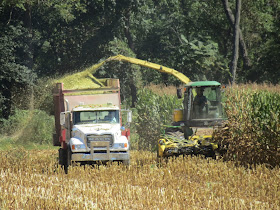A portion of the U.S.
population thinks that milk comes from the grocery store. In a way, that is correct, but first, the
milk is produced by cows before it makes its way into plastic milk jugs and is
available for purchase at grocery stores.
The process is
long. It takes a pregnant cow to produce
milk. And, it takes plenty of high
quality feed for that cow to get through the nine month gestation period and to
the point of producing quality milk.
One such feed is
silage, corn plants chopped when at about 35% moisture and piled to ferment. This is one of several feeds that are fed to
milk cows. Milk cows require a higher
quality feed than beef cattle and silage is a wonderful food source which helps
promote milk production. The dairy farmer is always striving to increase the
quality of his feed resulting in a higher quality herd and milk…all the better
for human consumption and health.
I have never seen
corn being chopped for silage; that is, until this week.
 As mentioned in my
previous blog, Glenn was helping a local farmer friend with the task of chopping
his 2015 corn crop for silage. Glenn was
one of two truck drivers. Glenn mentioned to me that I should come by to see
the process. I was interested, so I did.
As mentioned in my
previous blog, Glenn was helping a local farmer friend with the task of chopping
his 2015 corn crop for silage. Glenn was
one of two truck drivers. Glenn mentioned to me that I should come by to see
the process. I was interested, so I did.
This year’s corn
crop, as well as many other plants including those growing in my garden, benefited
by an abundance of spring/early summer rain.
This corn was tall.
I watched as the
chopper cut the rows, about 11 at a time, and blew the chopped vegetation out a
spout aimed at a large hauling truck, moving alongside this chopper, which
collects and hauls the chopped corn back to the barn lot to be stored and to
ferment in concrete silage bunkers. The
actually chopping took place sight unseen within the huge silage harvester.
The huge truck filled
fast. A second truck was waiting to slip
into line to collect the next rows.
The filled truck
drove back to the barn lot and unloaded.
This particular truck has a mechanism to push the contents out rather
than raise and dump. Then, a weighed
tractor packed the chopped corn into the concrete bunker. This chopped corn ferments and is stored until
needed for feeding.
 I was fortunate, too,
to be able to drive as a passenger in the truck and as a passenger in the
chopper. I saw the process from a front
row seat. Now, that was exciting!
I was fortunate, too,
to be able to drive as a passenger in the truck and as a passenger in the
chopper. I saw the process from a front
row seat. Now, that was exciting!
There are many steps
to the end result of silage. Preparing the soil, planting the corn seeds,
hoping for and receiving adequate rain, cutting and chopping the entire corn
plants (stalk, ears and leaves), and storing
and fermenting the chopped corn are the basic steps.
The cows are happy to
have nutritional and tasty feed.
Milk consumers are
happy to purchase their milk so simply.
Hurray for farmers!
Ok, Ok…I know I am a
bit biased because my family is a family of farmers, but the sentiment does not
change…hurray for farmers!






No comments:
Post a Comment